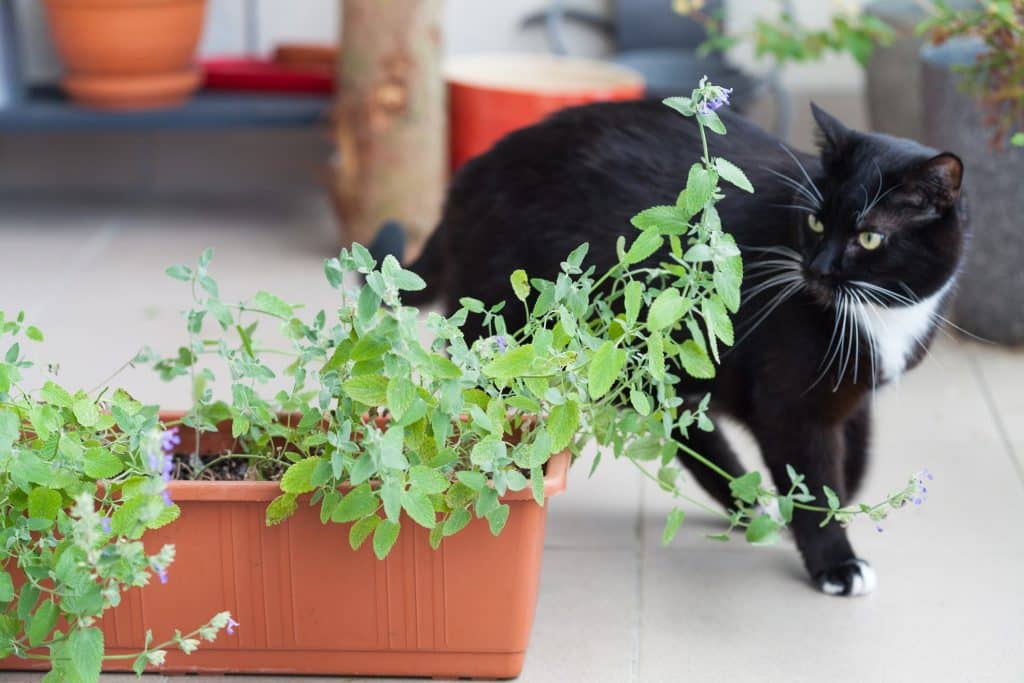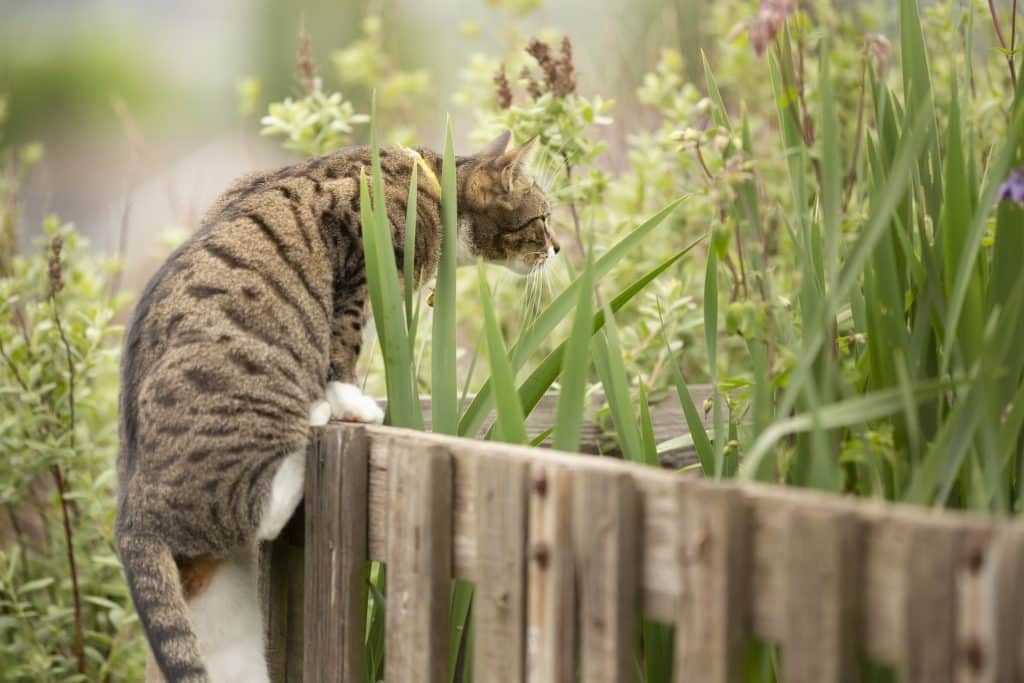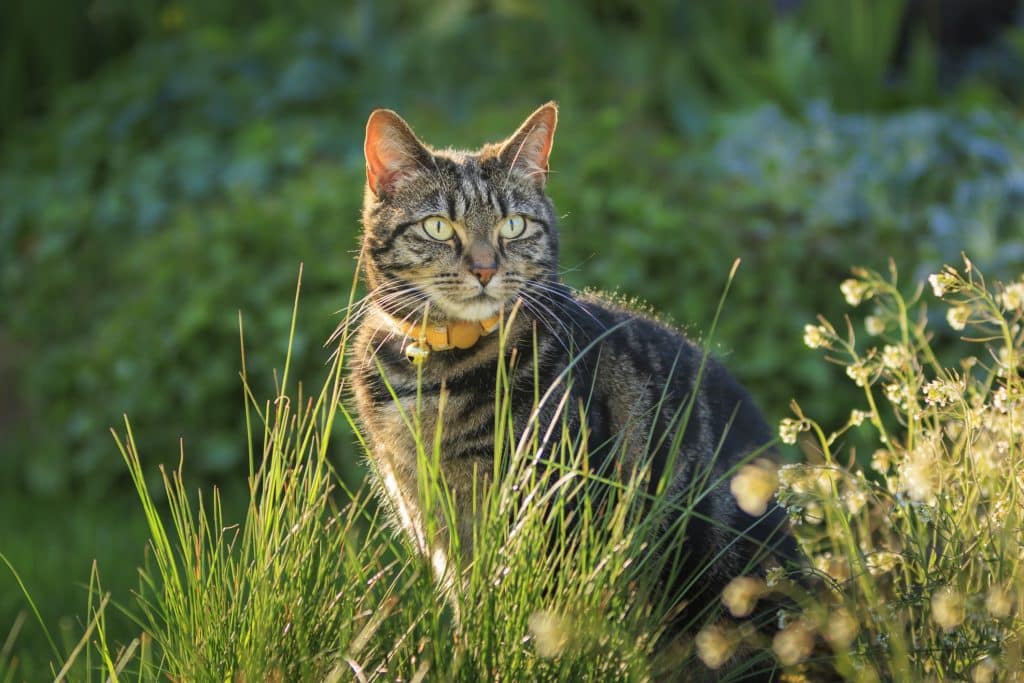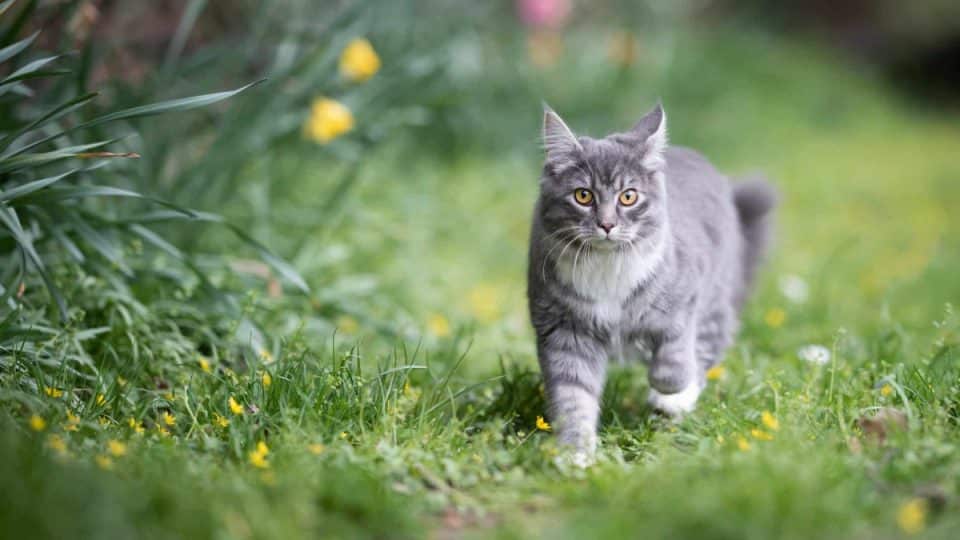- This post contains affiliate links. Read more here.
- Not a substitute for professional veterinary help.
Are you tired of finding unwelcome presents from neighborhood cats in your yard or dealing with your adventurous cat unintentionally destroying your plants?
“Cats are hunters, and they may wander into your yard out of curiosity, mating, hunting, or shelter seeking,” says Meaghan Thomas, DVM, a veterinarian at East Ridge Animal Hospital. A feral cat—or your neighbor’s outdoor cat—does not understand property lines! They wander to places where they feel safe, have found a food source, or have found something piquing their interest. Unfortunately, she says, due to the outdoor cat population, they often find themselves in places they weren’t invited into.
Let’s explore a range of solutions for different situations and preferences that will give you a cat-free outdoor space without causing any harm to curious cats or other wildlife. From non-chemical methods to non-structural defenses, we’ve got you covered!
1. Invest in Cat Repellents
Commercial cat repellents—like Nature’s Mace Cat Repellent, bitter apple products, or pet sprays like PetSafe SSSCAT Spray Pet Deterrent—provide a potent line of defense against feline intruders. If you’re worried, cat mace is sprayed on the ground, not on your cat.
These products work by emitting scents and a taste cats don’t like. This effectively deters them from entering treated areas. Compared to homemade solutions, commercial cat repellents are often more powerful. One advantage of these repellents is their targeted effectiveness, making them helpful in repelling cats from specific areas like windows or flower beds. In addition, they create a clear boundary cats are less likely to cross. Though powerful, these products are designed to be safe for humans, pets, and other cats when used correctly. Despite their effectiveness, commercial cat repellents require regular reapplication to maintain their potency and may emit noticeable odors, which should be considered.
But if you prefer non-chemical solutions or seek a more passive approach, these repellents may not be for you.
Cat repellent pros:
- Highly effective
- Easy to apply
- No need for physical structures
Cat repellent cons:
- Contains chemicals
- Need to reapply over and over

iStock/dzika_mrowka
2. Use Plants to Deter Cats
Are there plants that repel cats? Yes! This is a natural way of keeping those crazy kitties out of your yard or garden. Since cats are sensitive to smells, Dr. Thomas says a little goes a long way. She recommends putting a small amount of citrus in your yard or garden since cats hate that smell. Additionally, she suggests other plants, like Coleus caninus (Scaredy Cat Plant), give off an offensive odor to cats without harming them. Some final plants cats notoriously dislike are lavender and rue.
Relying on plant deterrents offers an environmentally friendly alternative to chemical repellents and adds beauty to your outdoor space. However, while plants can play a role in deterring cats, combining them with other methods, such as physical barriers or deterrent sprays, is even more effective.
Plant pros:
- Completely natural (no chemicals)
- Rarely need to replace
Plant cons:
- Not quite as effective as chemical repellents
- Need to water and care for the plants
3. Try Structural Solutions
Structural solutions offer a practical approach to keeping cats out of your yard and garden. Cat mats, motion-detecting sprinklers, tape barriers, and netting can create physical deterrents. When approved by a veterinarian, cat mats are uncomfortable for cats to step on, discouraging them from entering treated areas.
But are cat mats safe? Dr. Thomas says they are and to lay them in your vegetable or flower garden so the plastic spikes can deter critters. One cat mat she likes is the Homarden Scat Mat for Cats. As always, read reviews and make sure you purchase a mat that advertises flexible and blunt spikes, as these spikes do not cause harm—they deter animals from wanting to walk or lay on them.”
If pet parents don’t want a cat mat, motion-detecting sprinklers startle cats with bursts of water, deterring them from venturing further. Tape barriers and netting create physical obstacles, blocking access to specific areas. These structural solutions provide tangible barriers to help protect your yard and garden from unwanted cat visits.
Dr. Thomas prefers structural solutions, recommending cat-proof fencing if possible. Additionally, she says cat mats, motion-sensor sprinklers, scent deterrents, or ultrasonic systems are all good choices.
Structural pros:
- No chemicals required
- Set it and forget it
- Most solutions are non-harmful
Structural cons:
- If using a cat mat, it’s essential to research to find non-harmful ones
- Structures can be visually unappealing

iStock/kelvinjay
4. Lure a Cat Somewhere Else
Encouraging a cat to visit a designated area in your yard just for them can redirect their attention away from your central garden or yard. This approach works well for pet parents with outdoor cats. Providing a designated space, such as a cat house or a section planted with cat-friendly plants like catnip or catmint, can entice cats to explore and play there instead.
You can also try planting cat grass, using a cat grass kit like The Cat Ladies Cat Grass Kit (100% Organic) to help save your indoor plants, or purchasing catnip toys to attract your cat away from your precious plants.
By creating an attractive and inviting environment specifically tailored to their needs, you can effectively steer cats away from sensitive areas while allowing them to enjoy the outdoors. This method not only helps protect your main garden but also enhances the well-being of your outdoor cat.
Lure a cat pros:
- Keeps your cat happy and entertained without them destroying your garden
Lure a cat cons:
- This can attract more cats to your yard
5. DIY or Purchase At-Home Solutions
DIY and at-home solutions offer a budget-friendly and creative approach to deterring cats from your garden or yard. While these solutions might not achieve the same results as commercial products, they can still be worth exploring. For instance, scattering citrus peels, coffee grounds, or cayenne pepper around your garden might deter cats due to their strong scents.
Additionally, homemade sprays using vinegar, citrus juice, or essential oils mixed with water can be applied to specific areas. Remember that the results of these DIY solutions are anecdotal, and pet parents should understand their effectiveness may vary. Nonetheless, these DIY deterrents offer a starting point for pet parents searching for simple, readily available options to help keep cats at bay.
DIY solution pros:
- Cheap, quick, and easy to make
DIY solution cons:
- May not work as well as a commercial product

iStock/kelvinjay
How We Chose
The featured products were selected based on hands-on testing, a comprehensive breakdown of customer reviews across various retail platforms, and interviews with veterinary experts. As a result, we prioritized factors such as efficacy, safety, and practicality. We’re also guided by the experience of living and playing alongside our much-loved and strongly opinionated pets, who are never stingy with their feedback.
We asked Dr. Thomas for her opinion on what solutions she would discourage people from using. “I do not support the use of anything that could cause harm to a cat,” she explains. “There are many ways to safely deter cats from entering your yard without harming the cats themselves.”
She advised pet parents to check out NeighborhoodCats.org for information on outdoor cats and ways to deter them from entering their yards. The entire premise of this organization is to improve outdoor cats’ quality of life and keep them safe without disrupting people who may not enjoy their company.


